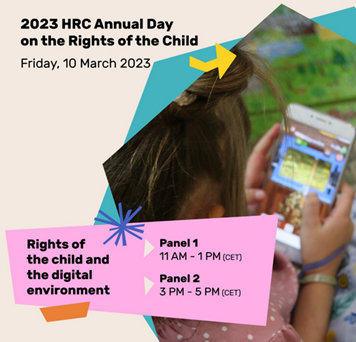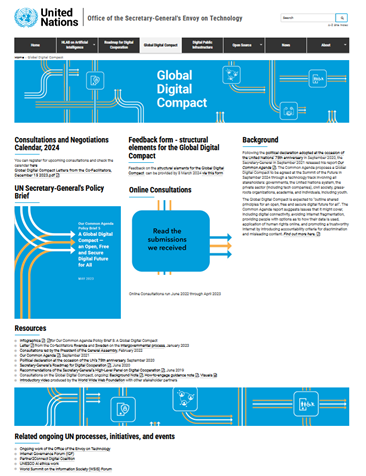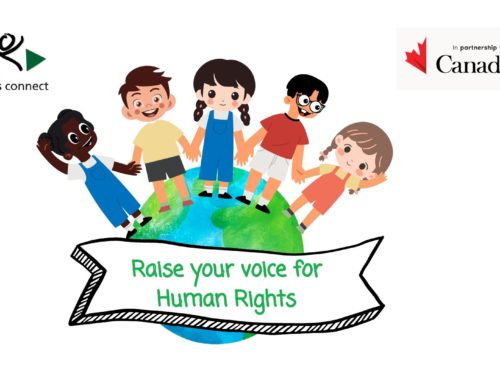Download the visual on these results here!
Children’s voices historically ignored at the Human Rights Council
The UN Human Rights Council is the main intergovernmental body within the United Nations (UN) responsible for advancing human rights around the globe and for addressing situations of human rights violations and making recommendations on them. The Annual full-day meeting on the rights of the child (ADRC) is a yearly celebration and discussion on children’s rights during the March session of the Human Rights Council. Typically, this one-day panel discussion gathers experts from across the globe to discuss specific topics affecting children’s rights. Symptomatic of a wider trend, for decades, we have seen children being excluded from discussions and decision-making at the Human Rights Council, including as part of the ADRC, designed to promote and protect their rights. Before 2019, due to their widespread consideration as vulnerable persons and due to adults’ fear of tokenism, not a single child had participated in the ADRC in any form. For decades, children have been denied their right to voice their views and influence decisions affecting their lives. Yet, the invaluable role of children in shaping policies and decisions regarding their rights cannot be overstated. Experience has consistently demonstrated that facilitating open, regular, and secure child participation in high-level UN processes not only empowers children in advocating for their rights but also yields tangible positive outcomes at the national level. This is the reason why institutionalizing child participation in UN processes has been one of our key priorities. While continued efforts by civil society organisations (CSOs) and certain States have led to an increased level of child participation, sustained advocacy remains crucially needed to ensure institutionalized child participation at the ADRC.
Working with our members and partners, our restless efforts have contributed to reversing the trend of children’s exclusion from the ADRC since 2019. In 2019, a girl living with disabilities from Moldova (who had just turned 18) was able to speak on the panel. This marked a turning point in the European Union (EU) and Uruguay’s leadership on the ADRC and provided evidence of the value of engaging children in this process. This practice was further extended in the following years and in 2021, there was historic child participation, with a total of 7 children taking part in the event as panelists, civil society and state representatives. In 2022, despite the sensitivity of the topic covered by the ADRC (focused on the rights of the child and family reunification in the contexts of migration, armed conflict, and counterterrorism) we had worked with the organizers to ensure that children’s voices were part of both panels. And, for the first time, the OHCHR consulted children in the preparation of their report on this theme, with our support and that of Save the Children, one of our members. There was, however, more work to be done to ensure that the Human Rights Council becomes more inclusive.
What we did and achieved in 2023
First children’s panel at the ADRC on the digital environment!
Child participation at the Human Rights Council is one of our priorities and we advocate for the right to be heard of every child, enshrined in the United Nations Convention on the Rights of the Child (UNCRC), to be implemented. In 2023, the Annual full-day meeting on the rights of the child (ADRC) and the UN General Assembly Resolution on the Rights of the Child, the theme of which was the digital environment, as well as preparations for the Global Digital Compact, were key opportunities to drive awareness and reinforce global political commitment to the implementation of children’s rights in this area as set out in the UNCRC and its General comment No. 25 (on children’s rights in the digital environment). Ahead of the ADRC, we established with several members a Taskforce on child rights and the digital environment to influence both the process of the ADRC – for safe and meaningful child participation – and its outcome, the General Assembly resolution on the same topic, as well as the Global Digital Compact.

Caption: Flyer of the 2023 ADRC
Because we recognize the transformative potential of institutionalized child participation in key UN processes, jointly with others, we boosted our efforts for greater, and more meaningful, participation of children at the ADRC. As a result of these efforts, the 2023 ADRC had the highest number of child participants in the history of this event. Overall, 13 children, mostly girls, participated in the event in person! By bringing children to the table, on an equal footing with adults, we contributed to ensuring that discussions on children’s digital rights reflect children’s views and lived experiences. Children stood at the centre of the morning dialogue, making up, for the first time in the history of the Human Rights Council, the majority of the panel. It was also the first time a High Commissioner for Human Rights had the chance to have a conversation with children in this format. Several Member States and CSOs also encouraged child participation by allocating their speaking slot to child representatives. Member States such as Ireland, Lithuania, Luxembourg, Romania, the Netherlands, Uruguay, and Slovenia gave their speaking slots to a child representative from their respective countries. CSOs such as Amnesty International, Save the Children (a member of Child Rights Connect) and Plataforma por la Infancia (a member of Child Rights Connect) also gave their slots to children from Argentina, Indonesia, and Spain respectively.
“Child Rights Connect did such a great work at connecting the different organizations and bringing them into this space.” – Abril from Argentina, 17
Abril, a 17-year-old activist from Argentina, was the first child to participate at the Annual Day in person as a civil society representative. She called for more significant child participation in the creation of a safer and digital space. One of the child panelists reminded the Council that “children around the world suffer from various forms of violence, abuse and exploitation because they are deprived of participation on issues that matter to them” and he called on all relevant stakeholders to put prevention as the top priority in regulating the digital space before more children fall victim to physical and mental abuse. Mariana, a 12-year-old girl from Colombia, indicated that, to overcome the digital divide experienced by children in her mountainous area, she had created, with her group of friends, a mobile library that can travel throughout her community. The UN High Commissioner for Human Rights called on all relevant stakeholders to put the wellbeing of children and their rights at the center of policies while protecting children’s right to be heard through child participation. He encouraged States to use the UNCRC General comment No. 25 (GC25), which provides authoritative guidance on how to promote, respect, protect and fulfill all children’s rights in the digital environment.
While in Geneva, we built the capacity of the children participating at the ADRC to learn about the UN and how to undertake advocacy. They had the opportunity to put this knowledge into practice when meeting with the European Union delegation at the United Nations to discuss their priorities for the upcoming UN General Assembly resolution on the rights of the child and digital environment.
Influencing the outcome of the ADRC
Beyond the process, we also sought to influence the content. We developed a joint position paper to inform the discussions of the ADRC and delivered a joint NGO statement. Furthermore, we used the ADRC to influence high-level New York processes such as the above-mentioned UN General Assembly resolution on the rights of the child as well as the Global Digital Compact (part of the Summit of the Future, during which world leaders will gather to adopt “A Pact for the Future” addressing emerging challenges, including those posed by new technologies).

Caption: Screen capture of the Global Digital Compact
In our joint position paper, we highlighted the increasingly significant role that the digital environment plays across most aspects of children’s lives. One in three internet users is a child, and, especially since the COVID-19 pandemic, children’s development, their relationships, education and play, are increasingly mediated by digital technologies. Many schools are increasingly turning to e-learning. Children living in the Global South are finding it difficult to access the internet and digital devices and consequently to adapt to the digital pace at which the world is evolving.
Through the joint NGO statement delivered during the afternoon panel of the ADRC, we emphasized that “meaningful and equal access to safe digital technologies can support children to realize the full range of their civil, political, economic, social, and cultural rights” but that “children are not a homogenous group; their agency, age and maturity, and different needs must be taken into account”. We also called on States to develop and implement comprehensive policies and action plans for children’s rights in the digital environment in line with the UNCRC and GC25 and legislate to ensure business responsibility to respect children´s rights, prevent and remedy abuse of their rights in relation to the digital environment.
In parallel of the ADRC, jointly with other organisations, we hosted a side-event at the UN entitled “The Digital Future we want” during which the public was encouraged to reflect from the discussions and recommendations from children, on how they can be agents of change and child human rights defenders, and to commit to improve the digital environment for children. Children were at the core of event, both as panellists and moderators, exemplifying the shift toward more child co-led advocacy.
UN General Assembly groundbreaking resolution with 193 States committed to implementing children’s rights in the digital environment!
The inputs from the ADRC, influenced by children, were used to shape the UN General Assembly Resolution on the rights of the child led by the European Union and the Group of Latin American and Caribbean States in New York in the Fall 2023. Amidst some disagreement over language, the UN General Assembly adopted by consensus the Resolution on the Rights of the Child in the digital environment in November 2023. Echoing several key recommendations that we had voiced with other CSOs, the resolution notes that States parties should implement the Convention on the Rights of the Child in relation to the digital environment, including the importance of privacy to children’s agency, dignity and safety, and for the exercise of their rights. The resolution also calls for strong national legislation on data protection and privacy, stressing that companies should not prioritize commercial interests over the best interests of the child. As we had called for, it also requires to pay attention to child rights due diligence in impact assessments to mitigate potential risks to children’s rights. Despite the fact that UN resolutions are non-binding, the adoption by consensus marks a strong political endorsement of the requirements set out in the General comment 25 to the UNCRC. This creates political space for progress and provides civil society and children with a strong advocacy tool to press for the realization of children’s rights in the digital environment in a safe and empowering way.
What difference did this make
The unprecedented engagement of children in the ADRC marks a significant milestone in the advancement of child participation and rights. The expressed support from States for child participation reflects a growing understanding of the importance of including diverse perspectives, including those of children, in shaping policies and initiatives that impact their lives. Many States showed interest in continuing the practice of engaging children as panelists and supported the idea to find ways to consult more with children on resolutions, like the General Assembly resolution on children’s rights in the digital environment. This shows a growing recognition of the need to make governance mechanisms more inclusive and more effective in addressing the world’s most pressing challenges.
Our role in connecting different organisations, using interconnected advocacy avenues, and creating a common, safe space for children to elevate their views underscores the importance of collaborative efforts in driving meaningful change. By bringing together diverse stakeholders, we have facilitated dialogue, knowledge-sharing, and collective action to promote children’s rights on a global scale. Overall, the unprecedented engagement of children in the ADRC, coupled with the support from CSOs and States, signals a more promising future for children’s views and rights at the Human Rights Council.
What we have learned
Reflecting on these outcomes, it becomes evident that nurturing strong partnerships, both with our members, other CSOs and like-minded States proved foundational to undertake bold and groundbreaking actions to ensure that children’s views are heard in intergovernmental processes.
The ADRC has proven a key entry point to begin developing good practices for an empowering, safe and sustained participation of children at the Human Rights Council, which can serve as an inspiration for other intergovernmental bodies. After the ADRC, we organised debriefs with the child participants, civil society partners and States to identify what went well and what could be improved. During an informal debrief hosted by the Permanent Mission of Luxembourg, those States that had supported child participation coincided on the positive experience for the child participants and expressed the firm intention to work together to further improve child participation practices at the Human Rights Council.






Leave A Comment